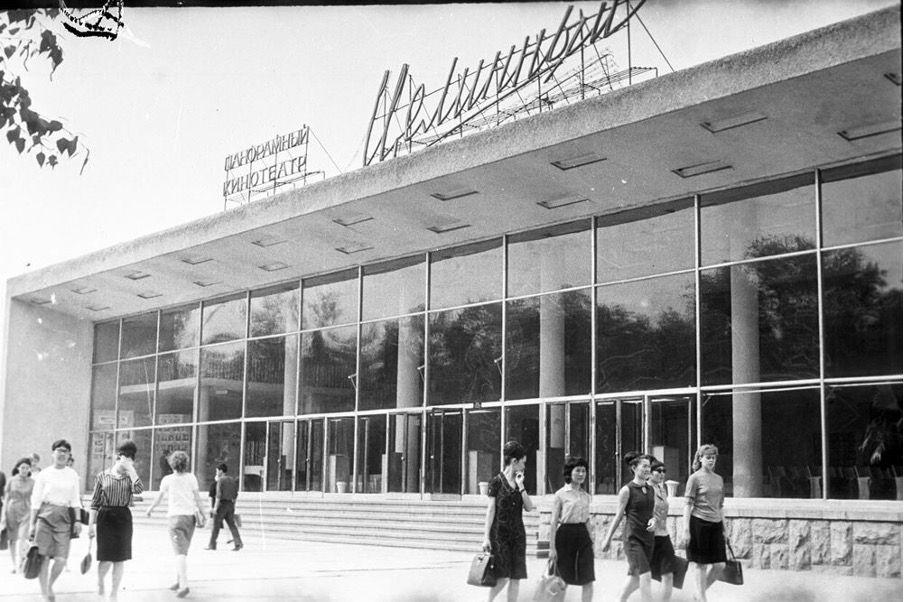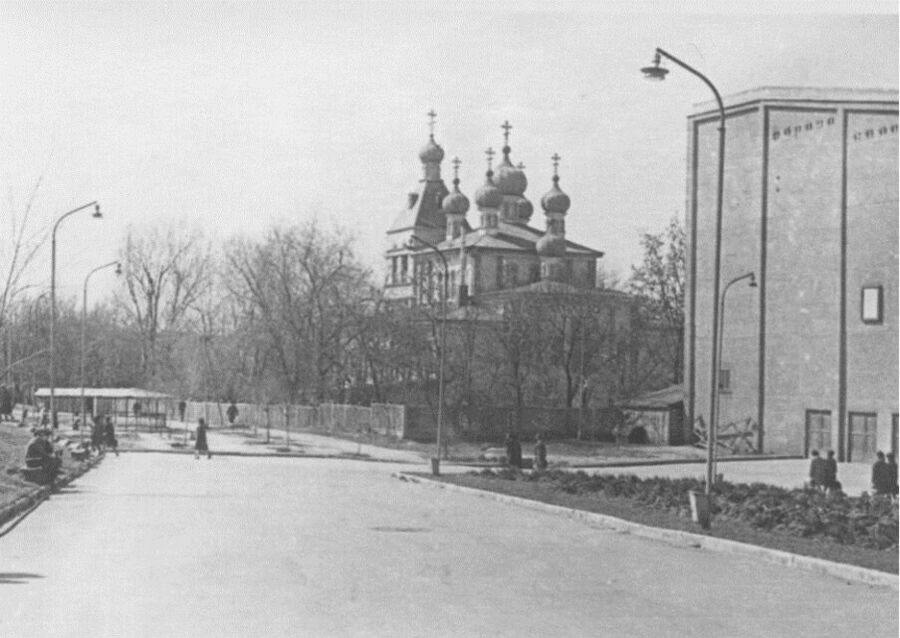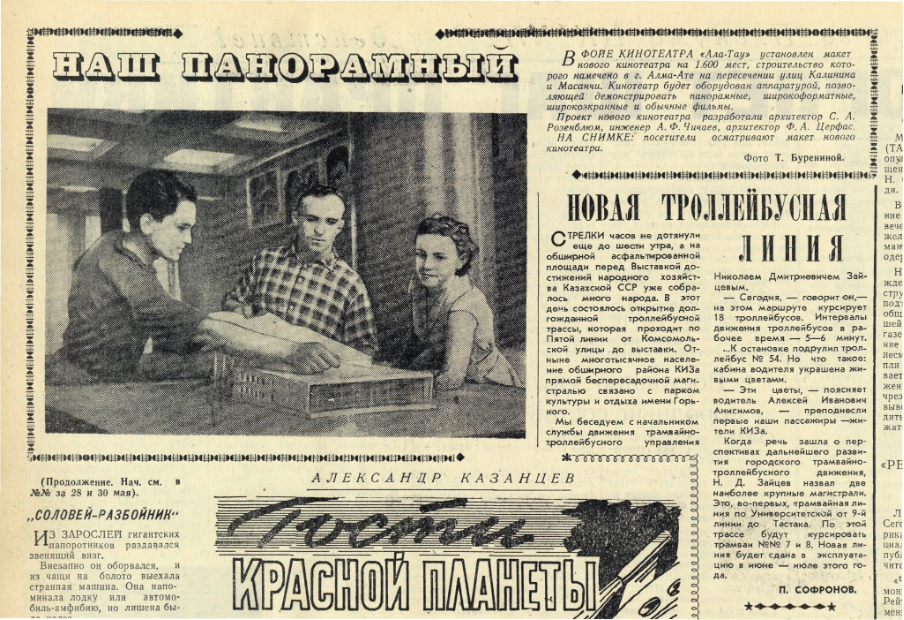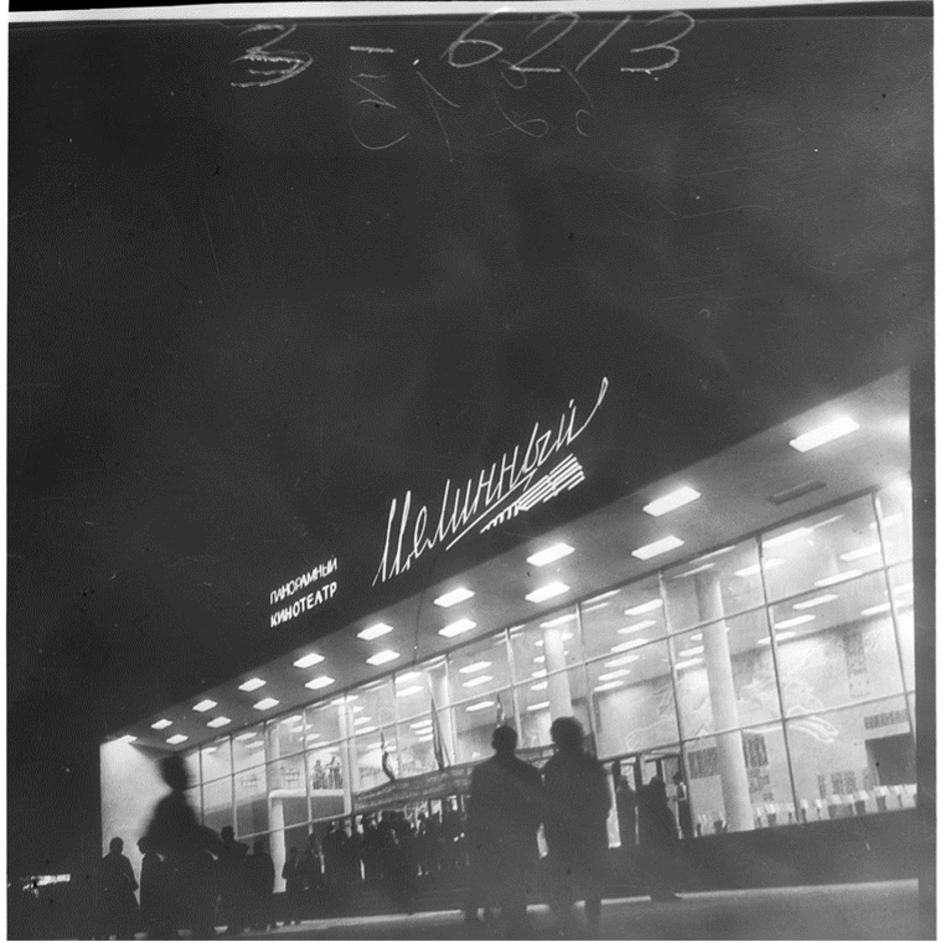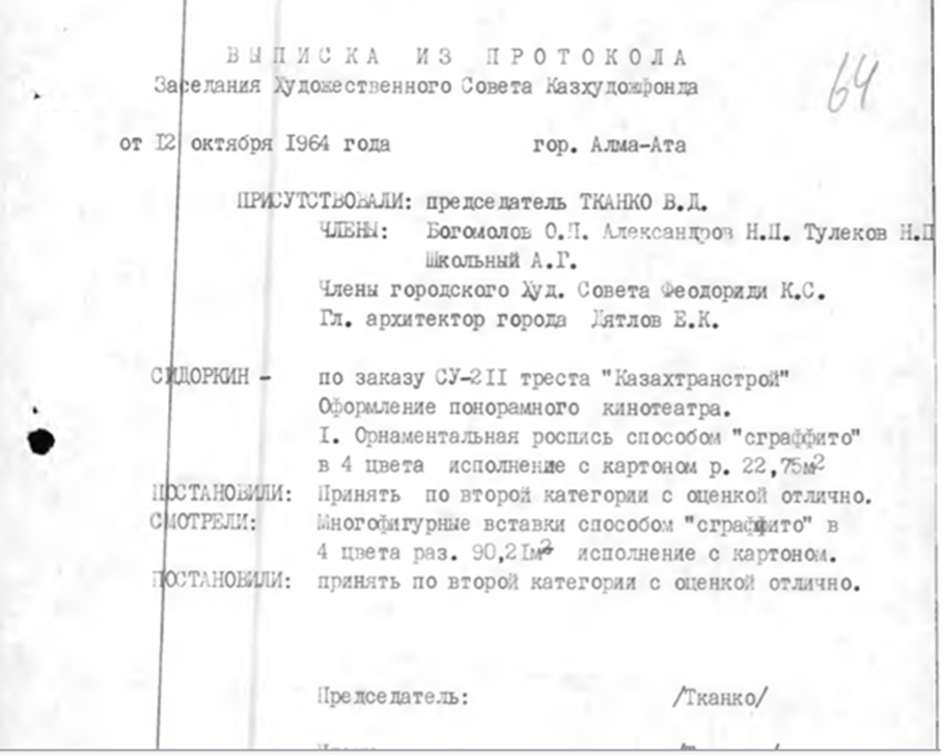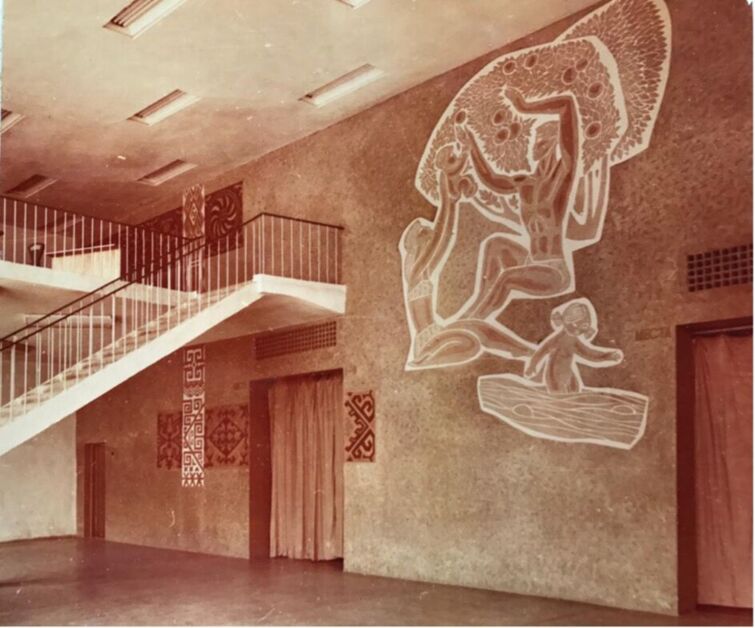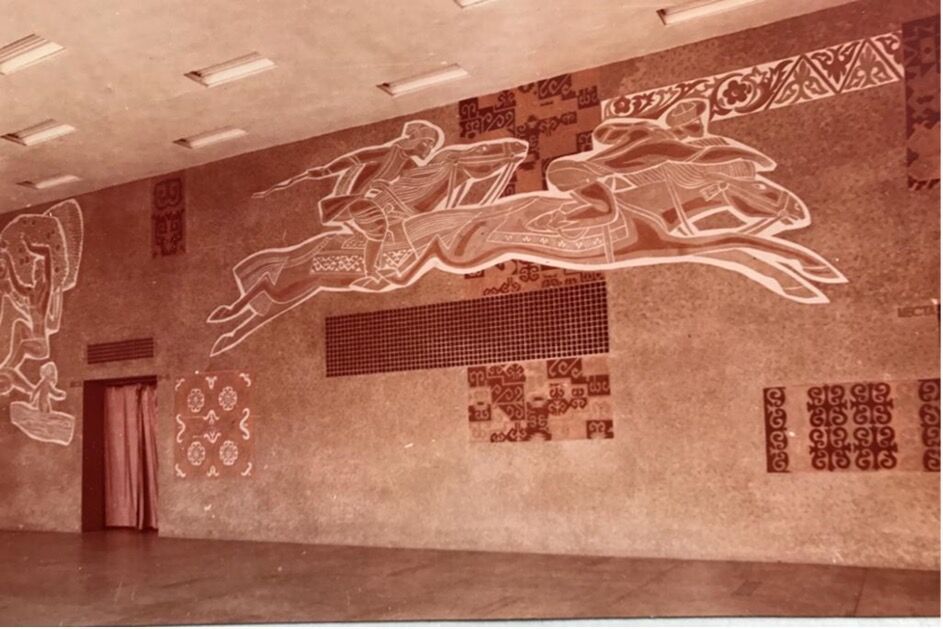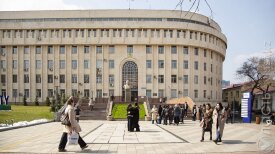When it opened in Almaty in the fall of 1964, the 1,536-seater Tselinny became the largest cinema in Kazakhstan. Sixty years later, it remains a landmark of Soviet modernist architecture. As part of the “A Place of Memory: Tselinny” project, developed with the Tselinny Center for Contemporary Culture, we delve into the building’s history, its iconic status, and its new life with the Center’s upcoming opening.
On 14 August 1962, city authorities designated a two-hectare plot of land at the intersection of Kalinin (now Kabanbai Batyr) and Masanchi streets for the construction of a cinema. Kalinin Street was a major landmark of Almaty in the 1960s, home to a popular pedestrian area nicknamed “Broadway” near the Opera and Ballet Theater (GATOB).
Kalinin Street ended at St. Nicholas Cathedral, built in 1906. At the time, authorities reportedly disliked that a street named after a communist leader ended at a church. Their solution: to "cover" the cathedral's view with a movie theater. Instead of demolishing anything, they erected a cinema on Proletarskaya Square.
Early project models referred to it generically as "a panoramic 1,600-seat cinema on Masanchi Street." Eventually, it was named Tselinny to mark the 10th anniversary of the Soviet Virgin Lands campaign, a Khrushchev-led agricultural initiative that, though celebrated at the time, is now seen as controversial.
Designed in Tashkent
The authors of the guidebook Alma-Ata: Architecture of Soviet Modernism are inclined to believe that Tselinny is a “standard” project, but the architecture researcher David Kaminsky points out that another movie theater, built in Tashkent at the same time, did not follow the same blueprint. If Tselinny were a typical project, we would see similar buildings. For example, the Mir and Sputnik cinemas in Almaty were “standard,” and this is immediately obvious.
Much remains unclear about the project's authorship. The renowned architect Vladimir Katsev, known for landmarks like the Almaty Circus and Medeo skating rink, was once thought to have designed Tselinny. However, his daughter, actress Marianna Pokrovskaya, disputes this claim.
City archives point to Tashkent architect Saveliy Rosenblum as the project’s designer. In April 1964, Rosenblum was tasked with finalizing critical details, including the foyer layout, ceiling materials, and decorative lighting. Some of his decisions were cleared by Uzgosproekt, a design organization located in Tashkent. Rosenblum also designed Tashkent’s Museum of Arts.
A document dated 26 March 1964 states: “Considering the experimental nature of the facility, the constant presence of a representative of the author’s supervision is necessary during the pre-launch period, and we ask the management of TashZNIIEP to send a representative to Alma-Ata from March 10.”
Rather than “standard,” Tselinny was experimental.
Construction in Almaty was overseen by Boris Tyunin of Kazgorstroyproekt, an organization led by Katsev at the time, which likely caused the confusion over the building's authorship.
Modernist Marvel
In 1955, following the death of Stalin, the Communist Party decreed an end in architectural excess. These were the first signs of the thaw.
Tselinny embodied this shift, featuring one of Almaty’s first glass facades. By day, its reflective surface mirrored the street; by night, its lights captivated passersby. According to architect Zhanna Spooner, this worked better than any advertising.
The cinema's foyer was too small for a 1,500 seat capacity. Old photographs show crowds standing before the screenings in the square in front of the building. At the time, cinemas were planned to have small foyers to save on construction costs.
Though small, the foyer’s standout feature was a striking sgraffito by Yevgeny Sidorkin. At a 1964 meeting of the Kazkhudzhfond artistic council, the plan for the "ornamental painting in the sgraffito method, executed in four colors" was accepted with an "excellent" rating.
With the approval locked in, Sidorkin picked up his tools and started working with his aides. "My father always worked with a team of craftsmen. They were good specialists from the Oner plant. At the time, state commissions served the entire Republic,” Vadim Sidorkin, Yevgeny’s son, recalled in an interview with Vlast.
“He always cut sgraffito by himself, because it was his freehand drawing. He cut the plaster on the scaffolding himself. Each layer of plaster had its own color, so his works had a truly unique artistic quality," Vadim Sidorkin said.
The sgraffito was originally meant to be a different color: The background was terracotta, the outline of the drawing was white and dark brown. But then it turned into black, white and gray.
In an effort to open ahead of the November holidays and the celebration of the decade of Russian art at the end of October, the cinema was built quickly. On 17 October 1964, the Kazakhstanskaya Pravda newspaper wrote that the new panoramic cinema opened with the film “Optimistic Tragedy” about the events of 1917.
Three days later, the Leninskaya Smena printed a photo of happy students from the medical university standing by the box office of the new cinema.
Just one week after opening, Tselinny hosted a film festival. The first title was The Tale of Flaming Years, the first Soviet wide-screen feature film about World War II.
Because of the celebration of the decade of Russian art and literature, several Soviet “star” actors visited Almaty: from Sergei Bondarchuk and Alla Larionova, to Tatyana Samoilova and Zinaida Kiriyenko.
On 19 November, the authorities finally issued the “acceptance certificate,” essentially signing off on the building and its decorations.
The authorities also placed a marble plaque outside the cinema, saying: “The cinema was built in 1964 in honor of the 10th anniversary of the virgin lands policy.” The numbers 1964 camped at the entrance.
A Unique Experience
Unlike any other cinema of this time, the screen was covered with luxurious velvet curtains that opened before each showing. Like in a theater, the distance between the rows of seats was unusually large and time was clocked by three bells, one rang 15 minutes before the start, while the last one rang just when the film was about to begin.
The box office was located on the side of the building, with a ramp leading to a separate entrance. From there, people could access the Nikolsky Market, now turned into a parking lot for police cars.
One of the cinema directors in the 1960s even dreamed of having a resident orchestra. While this turned out unfeasible, local media reported that pop groups performed in the cinema. The foyer also often hosted photo exhibitions.
It would take some time before other cinemas caught up with Tselinny’s latest film technology and air conditioning. People could also enjoy a buffet and peruse a book stand in the foyer.
From 10 am with shows for children, Tselinny worked until late at night.
Actress Marianna Pokrovskaya, the daughter of architect Vladimir Katsev, studied at school #25 on Kalinin Street (Kabanbai Batyr), told Vlast that she and her classmates often ran to Tselinny.
“We watched movies in Tselinny, Alatau, and Arman. Tselinny was the largest cinema, and people were breaking in, it was impossible to get tickets. There were two schools nearby, and schoolchildren went there in crowds. As you enter, the first thing that catches your eye is the huge wall with Sidorkin’s sgraffito. This made the building special, atypical,” Pokrovskaya said.
“The high ceiling gave you this feeling of space. It was possible to enjoy some tomato juice and a croissant from the buffet. When you also managed to watch a movie, that’s it, it was happiness.”
Tselinny was the first, the only, and the last panoramic cinema in Kazakhstan. But that did not last long. A lack of movie titles in that format led management to switch to a wide-screen format.
Поддержите журналистику, которой доверяют.
